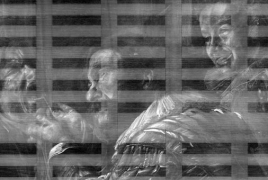N. Carolina Museum, Duke University to develop art conservation tool September 10, 2015 - 13:36 AMT PanARMENIAN.Net - North Carolina Museum of Art partnered with Duke University to develop art conservation tool, Art Daily reports. X-ray radiography is a standard technique widely used by art conservators, art historians, and curators to discover information about the manufacturing process and the condition of a painting. However, cradling—wooden slats attached to the back of many old paintings executed on wooden panels—creates lattice patterns that appear as grids or a series of stripes on an X-ray image (pictured above). These patterns can obscure the image and distract art conservators from reading the image and analyzing paint layers. “Cradle patterns in X-ray images has been an ages-old problem for conservators studying collections of Old Master paintings, and until Platypus, required many hours of tedious manipulation of the X-ray image in Photoshop or various other techniques, some of which could be damaging to the painting,” says William Brown, chief conservator at the NCMA. “We have been fortunate to work with world leaders in the fields of time-frequency analysis, informatics, and image processing to come up with a practical solution to a difficult problem.” The cradle pattern problem appeared while Rujie Yin, research assistant in Duke University’s Mathematics Department, was using X-ray images to research a 14th-century altarpiece by Francescuccio Ghissi for an upcoming exhibition at the NCMA. Yin, attempting to study crack patterns in the altarpiece for an image-processing component of the exhibition, was frustrated at the distracting cradling and decided to use mathematical algorithms to solve the problem. The Math Solution: Image Processing Algorithms—and Collaborations Museum conservators and Duke University mathematicians worked together to develop the tool. Noelle Ocon, NCMA conservator of paintings, identified objectives of the project based on art conservators’ challenges with X-ray images. Yin and Duke University professors Ingrid Daubechies (Mathematics Department and Electrical and Computer Engineering Department) and David Dunson (Statistics Department) developed an algorithm that was successful in removing the cradle pattern from the X-ray image. When comparing the algorithm to the time-consuming technique of manually altering the image in Photoshop, it was discovered that the algorithm was not only quicker and more effective, but also much easier for art conservators to use. Describing the algorithm, Daubechies explains, “The algorithm consists of a three-stage procedure. First, the cradled regions are located automatically. The second step consists of separating the X-ray image into a textural and image component. In the last step, the algorithm learns to distinguish between the texture caused by the wooden cradle and the texture belonging to the original painted wooden panel.” Next, Bruno Cornelis, postdoctoral fellow in Duke University’s Mathematics Department; Gabor Fodor, research assistant in the Free University of Brussels’ Department of Electronics and Informatics; and others worked on coding and the user interface. The algorithms and coding were then converted into a conservator-friendly Photoshop plug-in tool that works effectively and quickly to remove the cradle pattern. The project was funded by the Samuel H. Kress Foundation. Says Brown, “We are extremely grateful to the Samuel H. Kress Foundation for awarding the generous grant that allowed us to study and solve this problem. Because of their support, we have developed a tool that will make a tremendous impact on art conservation for years to come.” The Platypus program was introduced at a workshop in August 2015 attended by national and international art conservators. After receiving feedback from the conservators, the NCMA and Duke University worked to finalize the software and coding, which is now available free online. Art + Science Initiative The collaboration between the NCMA and Duke University is part of the NCMA’s Art + Science Initiative, which enlists local universities to research issues concerning both art and science, bringing technological advances to art conservation, and demonstrating the importance of interdisciplinary studies. The Museum’s Conservation Center has partnered with Duke University on other conservation projects, including applying laser imaging technology to research materials used in paintings (designed by Warren S. Warren, director of Duke University’s Center for Molecular and Biomolecular Imaging). The project is also part of the Information Initiative at Duke (iiD), an interdisciplinary program designed to increase “big data” (information characterized by tremendous volume, variety, and rapid change) computational research and expand opportunities for student engagement in this rapidly growing field. The creative crew of the Public TV had chosen 13-year-old Malena as a participant of this year's contest. She called on others to also suspend their accounts over the companies’ failure to tackle hate speech. Penderecki was known for his film scores, including for William Friedkin’s “The Exorcist”, Stanley Kubrick’s “The Shining”. The festival made the news public on March 19, saying that “several options are considered in order to preserve its running” Partner news |